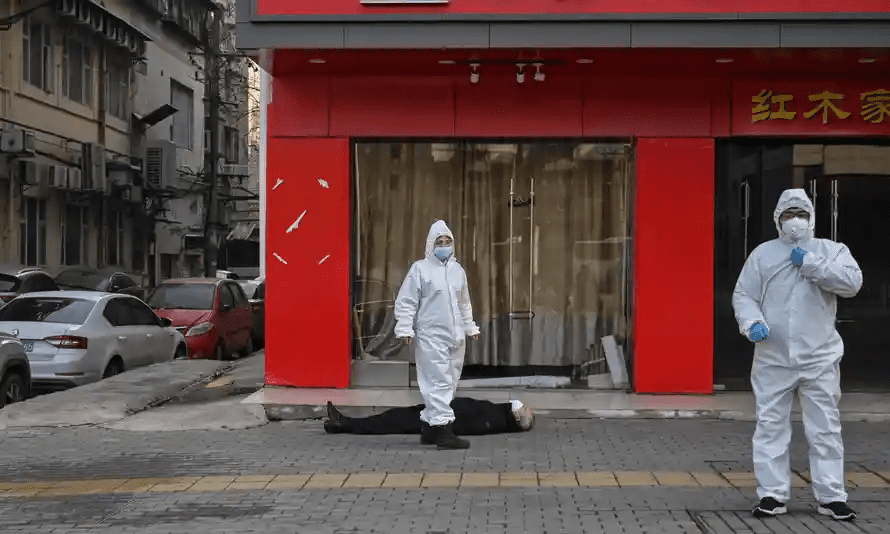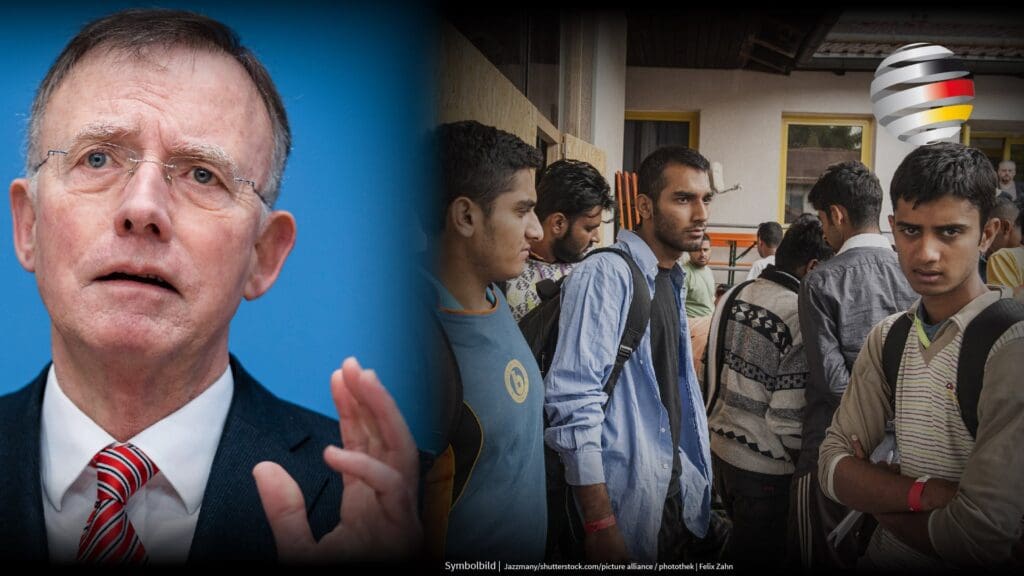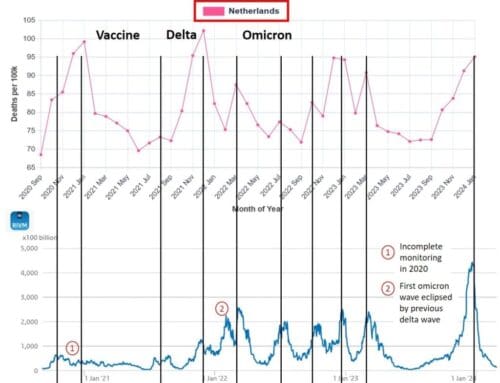

The Lockdown Lunacy in Retrospect

Published: March 2023
Share on: Twitter / Facebook
How and why most of the world succumbed to the lockdown lunacy.
The failure of lockdowns
As is well established by now, lockdowns were an almost complete failure as a strategy to suppress or contain the flu-like novel coronavirus: in most cases, lockdowns failed both to “flatten the curve” in the short term and to reduce cumulative excess mortality in the long term (see chart below).
Indeed, no-lockdown states achieved a perfectly average or even a below-average pandemic excess mortality compared to the their regional peers, as shown by Sweden in Western Europe, Belarus in Eastern Europe, Florida in the United States, Brazil and Nicaragua in Latin America, Japan in East Asia, or Tanzania in Black Africa.
Two exceptions to the widespread failure of lockdowns were preemptive lockdowns in support of early border controls, mostly on islands or in remote countries, and extreme Chinese “starve-at-home” lockdowns that shut down entire megacities whenever a few infections were detected. Yet even these strategies ultimately collapsed, after more than two years of isolation, against more infectious and vaccine-escaping coronavirus variants.
Lockdowns did succeed, however, in causing perhaps unprecedented social and economic disruptions. According to the World Bank, lockdowns caused an “historically unprecedented increase in global poverty” of close to 100 million people, and according to UNICEF, over 150 million children missed school for more than a year. In many countries, unemployment, bankruptcies, drug abuse, and psychological problems soared to record levels.
Unlike the targeted isolation of sick patients and their immediate contacts, complete nationwide lockdowns have never been part of the established public health response to epidemics and pandemics. It is important to understand, therefore, how exactly the near-global adoption of such an irrational and destructive measure during the recent covid pandemic came about.
Figure: The failure of lockdowns and masks – Germany vs. Sweden. (Ian Miller)

The drivers of lockdowns
The biosecurity strategy
While complete lockdowns have never been part of the established public health response to epidemics and pandemics, they were and are an important component of the biosecurity strategy first devised in 2005 by the US Department of Homeland Security (DHS). This strategy was developed in the context of potential bioterrorist attacks and catastrophic global pandemics that might decimate entire populations.
The DHS biosecurity strategy, which was partially incorporated into pandemic guidelines both by the US Center for Disease Control and Prevention (CDC) and the World Health Organization, featured already most of the key concepts applied during the covid pandemic, including stay-at-home orders, mass closures of schools and businesses, the idea of “essential workers”, and “social distancing”.
The general idea of the biosecurity strategy has always been “maximum suppression until mass vaccination or mass medication”. It was in the context of this strategy that US biosecurity planners, led by the US Defense Advanced Research Projects Agency (DARPA), began developing – together with companies like Moderna, Pfizer and Curevac – novel mRNA vaccines. The assumption was that these vaccines could be designed and deployed much faster than traditional vaccines, many of which require cumbersome culturing and isolation methods.
The principal author of the 2005 US biodefense and pandemic response strategy was Dr. Richard Hatchett, Director for Biodefense Policy on the United States Homeland Security Council at the time. In 2017, Dr. Hatchett became CEO of the Coalition for Epidemic Preparedness Innovations (CEPI), which was founded that year at the World Economic Forum (WEF) by the Gates Foundation, the British Wellcome Trust led by Dr. Jeremy Farrar, and several governments.
During the coronavirus pandemic, CEPI played a central role in the global mass vaccination effort. Already on 23 January 2020, CEPI CEO Dr. Hatchett, Wellcome Trust director Dr. Farrar, and Moderna CEO Dr. Bancel held a first press conference at the WEF in Davos. On March 6, in a very influential interview with British Channel 4, Dr. Hatchett described covid as “the most frightening disease I’ve ever encountered in my career” and called for a global “war” against the virus.
FOIA documents later revealed that in the United States, the pandemic response at the federal level was managed not by public health officials, but by the National Security Council and the Department of Homeland Security. In Germany, too, key lockdown proponents previously participated in various biosecurity exercises. In mid-March 2020, then US Secretary of State and former CIA Director, Mike Pompeo, even spoke of the coronavirus pandemic as a “live exercise”.
In the wake of the pandemic, CEPI launched its “100 days mission”, adopted by the G7 countries, to develop and deploy vaccines against any novel pathogen even faster, while Dr. Farrar, who had promoted both the failed lockdowns and the bogus “animal market” virus origin theory, became chief scientist at the WHO. In Britain, Public Health England was turned into the UK Health Security Agency. In the US, production of Moderna mRNA vaccines was transferred to a company linked to the US National Security Council and the CIA.
Figure: Dr. Richard Hatchett on Channel 4 (March 6, 2020)

The Ebola lockdowns (2014-2016)
The covid pandemic was not the first time lockdowns were imposed in response to a virus outbreak. In fact, already during the West African Ebola outbreak in 2014 to 2016, which killed about 10,000 people, Liberia and Sierra Leone imposed multiple brief lockdowns to “curb the spread”.
At the time, the lockdowns were depicted as a success, but later studies found they were not effective, even though Ebola is thought to spread mainly sweat, blood and saliva, not via aerosols. Nevertheless, the Ebola lockdowns set a precedent for the management of such outbreaks.
The response to the West African Ebola outbreak was largely managed and funded by the WHO and US institutions, most notably the US CDC, the Gates Foundation, and shadowy Pentagon contractor Metabiota, which is led by one Nathan Wolfe, a WEF Young Global Leader.
At the time, it was claimed the Ebola outbreak was a natural event caused by a two-year-old boy who had touched a bat in a tree. But a recent phylogenetic investigation showed that this story was a myth and the outbreak was almost certainly linked to a US biolab in Sierra Leone, that is, the outbreak was either caused by a lab leak or it was part of a biosecurity live exercise.
The US biolab in Sierra Leone was led by two US professors, Dr. Robert Garry and Dr. Kristian Andersen. While Dr. Garry initially claimed their lab wasn’t working with Ebola, Dr. Andersen later admitted they were in fact working with Ebola. During the covid pandemic, both of these professors were key proponents of the bogus natural origin theory of the novel coronavirus.
Moreover, a recent investigation found that during the West African Ebola outbreak, a network of Twitter bots produced millions of posts promoting the imposition of lockdowns. During the covid pandemic five years later, such multilingual Twitter bots returned and demanded or praised covid lockdowns in many countries. At first, it was believed this might have been a Chinese cyber operation, but the Ebola precedent indicates that it was in fact a US cyber operation.
As will be shown below, several leading covid lockdown proponents were already involved in the management of the West African Ebola outbreak. Even CEPI itself was founded, in 2017, in response to the supposedly natural Ebola outbreak.
Figure: The Ebola lockdown in Freetown, Liberia (2014)

The Wuhan lockdown
On 23 January 2020, China imposed a very strict two-month covid lockdown on city of Wuhan and added travel restrictions on the entire province of Hubei, affecting close to 60 million people.
Although most Western politicians, health officials and journalists initially remained rather skeptical and viewed the Wuhan lockdown as an extreme Chinese measure inapplicable to Western countries, the Wuhan lockdown seemed to have been successful in suppressing the local outbreak and no doubt set a precedent for later lockdowns throughout the world.
Ironically, the apparent success of the Wuhan lockdown meant that many Western politicians and health officials began to calm down in February 2020, assuming the outbreak had been contained just like during the initial SARS outbreak in 2002/2003, only to then panic in March when domestic transmission was confirmed in many Western countries.
Some lockdown skeptics have argued that China somehow deceived Western countries into self-destructive lockdowns, but there is really no evidence for this hypothesis. China took the Wuhan lockdown and later lockdowns very seriously and was proud of its initial success in seemingly suppressing the virus. Only in late 2022 did the Chinese lockdown strategy collapse.
Rather, there is some limited evidence that the initial Chinese lockdown decision may have been influenced, to some extent, by Western input. The director of the Chinese Center for Disease Control is a member of the CEPI Scientific Advisory Committee, and according to a WHO official, Chinese CDC experts were trained by the US CDC Epidemic Intelligence Service.
Figure: A Chinese quarantine camp (January 2021)

The WHO covid report
The WHO itself never officially recommended full-scale lockdowns, and in some cases even recommended against additional lockdowns due to their severe impact on society and public health especially in developing countries. Nevertheless, the WHO did play an important role in the initial imposition of lockdowns outside of China.
On February 25, one month into the Wuhan lockdown, Dr. Bruce Aylward, a Senior Advisor to the WHO Director General, presented the WHO-China Joint Mission Report on COVID-19. Although the report did not directly recommend lockdowns, it described the Chinese response as a success and as “the only measures that are currently proven to interrupt or minimize transmission chains in humans.” The report also recommended to “immediately activate the highest level of emergency response mechanisms to trigger the all-of-government and all-of society approach that is essential for early containment of a COVID-19 outbreak.”
Dr. Aylward previously was “WHO Special Representative of the Director-General for the Ebola Response”, and in many ways, he viewed the coronavirus outbreak not as an unstoppable, global flu-like pandemic, but as localized, Ebola-like outbreaks that could still be contained.
Especially outside of English-speaking countries, the Aylward report initially had only little impact on the public debate, as few media outlets covered it in detail. This was probably because there were few Western experts participating in the WHO mission (most were from China and Asia), the press conference was held in Beijing (not in Geneva or in New York City), and in late February 2020, there was not yet known community transmission in Western countries.
However, behind the scenes, the Aylward report probably did influence the thinking of some Western health authorities. In late February 2020, Dr. Clifford Lane, a Deputy Director at Dr. Anthony Fauci’s NIAID and the NIAID liaison with the U.S. Departments of Defense and Homeland Security, wrote in an email: “China has demonstrated this infection can be controlled, albeit at great cost. This is the bottom line of the report from my perspective.”
In late March, in an interview hosted by the WEF, Aylward stated that “governments must keep their populations under lockdown while chasing down every suspect case for testing, and treating and isolating those who test positive”. Just ten days later, though, Aylward backtracked and stated that “lockdowns are not the best way to tackle Covid-19”.
The WHO caused additional panic by reporting a shockingly high covid “death rate” of 3.4%. This figure confounded the “case fatality rate” and the “infection fatality rate” and didn’t distinguish between age groups. Excluding nursing homes (about 50% of deaths in 1% of the population), the actual covid fatality rate was about 0.3% to 0.5% in most Western countries, and the average age of covid deaths was at or above natural life expectancy (i.e. 80 to 86 in Western Europe, 78 in the US).
On 11 March 2020, the WHO declared the coronavirus outbreak a pandemic. This was an important administrative step that set in motion a global response by governments. Back in 2009, the WHO famously removed the condition of “enormous numbers of deaths and illness” from its definition of a pandemic and declared the very mild swine flu virus a global “pandemic”, which triggered the rushed purchasing of mostly useless antiviral drugs (produced by Donald Rumsfeld’s Gilead) and of unsafe vaccines at a cost of billions of dollars.
Genetic analyses later showed that the 2009 swine flu virus was not a natural virus “from Mexico”, but a synthetic flu virus that either escaped from vaccine research or was released deliberately.
Figure: Dr. Aylward presenting the WHO China covid report (25 February 2020)

The Italian lockdown
In late February and early March 2020, Italy was the first Western country to impose a full-scale lockdown. The Italian response began on 21 February with a “red zone” encompassing ten municipalities in Northern Italy and was expanded into a national lockdown on March 9. British professor Neil Ferguson later stated that the Italian lockdown was a game-changer: “We couldn’t get away with it in Europe, we thought… and then Italy did it. And we realised we could.”
Due to its textiles industry, Northern Italy has close business links to China. Northern Italy also has one of the oldest populations and one of the worst air qualities in Europe, both of which amplified the impact of covid. Furthermore, local health authorities were caught off-guard and sent covid patients back to nursing homes to free hospital beds, while Eastern European nurses working in elderly care fled the country to escape the lockdown.
Based on publicly available accounts, three actors were crucial in implementing the Italian lockdown. First, the director of the Lombardy emergency services, Alberto Zoli, who felt overwhelmed by the local covid outbreak and demanded mass quarantine measures. Second, the Italian Health Minister, Roberto Speranza, who wanted to contain and suppress the covid outbreak in Northern Italy and who believed that a lockdown would benefit his political party, as it showed that only the state, not individuals or markets, could protect people against a pandemic.
The third actor was the Italian Kessler Foundation, which in February 2020 ran a “secret simulation study” that predicted close to one million Italian deaths without a full-scale lockdown. The Kessler Foundation is an Italian research institute specialized in “digital health” and “health emergencies”. The Foundation was already involved in the West African Ebola outbreak, during which it led a project called “Outpacing Pandemics” that was sponsored by the Wellcome Trust and the US Defense Threat Reduction Agency (DTRA). In 2017, Bill Gates referred to the work of the Kessler Foundation when he announced the founding of the Coalition for Epidemic Preparedness Innovations (CEPI).
On 19 March 2020, the well-known images of military trucks in Bergamo were broadcast around the world and contributed to hastened lockdown decisions in several European countries and US states that had not already imposed lockdowns by that time.
There is some limited evidence that the WHO or the US CDC might have influenced the Italian lockdown decision. On 30 January 2020, an anonymous US person with “friends and family at the CDC and WHO” posted the following message in an online discussion forum:
“[T]he WHO is already talking about how ‘problematic’ modeling the Chinese response in Western countries is going to be, and the first country they want to try it out in is Italy. If it begins a large outbreak in a major Italian city they want to work through the Italian authorities and world health organizations to begin locking down Italian cities in a vain attempt to slow down the spread at least until they can develop and distribute vaccines, which btw is where you need to start investing.”
On January 30, Italy stopped all inbound flights, and on January 31, both Italy and the WHO declared a state of emergency. In 2023, a US researcher possibly identified the anonymous message board poster as a US venture capitalist and tech industry investor.
In the summer of 2020, Italian Health Minister Roberto Speranza believed he had vanquished the Italian coronavirus outbreak and was writing a book about his success. The book was to be published in October of that year, but just when it was to hit book stores, the second and much broader Italian covid wave commenced and Speranza immediately recalled the book.
In Italy alone, domestic and international restrictions pushed one million citizens into poverty.
Figure: Military trucks in Bergamo (19 March 2020)

Fake Science and Modeling Studies
Bogus scientific studies and computer models were another important factor that contributed to lockdowns. There were two types of such studies: first, there were predictive studies that modeled an unlimited exponential rise in infections and deaths without lockdowns; second, there were retrospective studies that attributed any decline in infections to lockdowns and other measures.
All of these studies vastly overestimated the impact of lockdowns and other political measures and disregarded the central role of voluntary behavioral changes (such as staying home if sick), seasonal effects, and the spontaneous ending of infection waves that is well-known from influenza and many other respiratory viruses. When in April 2020 the first Swedish covid wave ended all by itself without a lockdown or a collapse of the healthcare system, modeling studies had to explain this fact away by introducing even more unrealistic assumptions.
While politicians claimed to “follow the science”, many scientists simply followed politics. The most notorious case probably was “professor lockdown” Neil Ferguson at Imperial College London, whose center is funded by both the Gates Foundation and the Wellcome Trust. Ferguson had falsely predicted doom in several previous cases, and his apocalyptic coronavirus modeling study, released on 16 March 2020, influenced the lockdown decisions of several Western governments.
Even after Sweden had proved these modeling studies wrong, various government experts continued to greatly exaggerate the impact of additional lockdowns, mask mandates, or PCR testing.
Figure: “The Hammer and the Dance” (Tomas Pueyo, March 19, 2020).

The International Monetary Fund
In addition to the institutions mentioned above, the American-European International Monetary Fund (IMF) also contributed to the imposition of lockdowns, especially in developing countries.
In June 2020, Belarusian President, Alexander Lukashenko, revealed that the IMF demanded lockdowns and other covid restrictions as a precondition for the provision of close to $1 billion in “Covid Relief Aid”. Belarus was one of the few countries that resisted lockdowns (see below).
Thus, lockdowns first caused unprecedented economic damage, especially in developing countries, and the IMF then demanded more lockdowns as a condition for providing financial aid.
Figure: The IMF Covid-19 Recovery Index (IMF)

Partisan Politics?
From a US perspective, it may look like the lockdown question was mainly a question of partisan politics, as many red states rejected lockdowns and other restrictions or lifted them rather quickly (e.g. Florida, Texas and North Dakota), while many blue states enforced strict measures and prolonged lockdowns (e.g. New York and California).
However, from a European and international perspective, the situation was more complex. In Europe, the nominally conservative governments of Germany and Austria enforced some of the strictest and longest lockdowns and mask mandates, while Sweden, governed by Social Democrats, rejected lockdowns and mask mandates. In Latin America, many countries enforced devastating lockdowns, but the left-wing Sandinista government in Nicaragua did not.
Furthermore, during the early phase of the pandemic, it was mostly conservative politicians who demanded border closures and restrictions, whereas many liberal politicians and journalists argued that such restrictions were useless, damaging, or anti-Chinese (i.e. racist).
Figure: Covid restrictions in red and blue US states (KBirb)

Demographics, Psychology, Technology
In Western countries, many people are old and fragile, while many young people are neurotic and easily scared and manipulated. Taken together, these demographic and psychological factors likely contributed to the panicked response and the repeated and prolonged imposition of lockdowns.
In Switzerland, the population could vote two times on covid restrictions and vaccine passports, and about 65% of voters expressed their support in both referendums. In Britain, 70% of the people stated, in a 2023 poll, that the government’s handling of covid had been “about right” or even “not strict enough”, while only 20% thought measures had been “too strict”. On the other hand, surveys found the British public overestimated covid mortality by a factor of one hundred.
An additional factor that may have contributed to the imposition and acceptance of lockdowns in Western countries likely was the widespread availability of digital means of communication, which allowed large parts of the middle and upper class to work remotely from the comfort of their homes. Just a few years earlier, this would not yet have been possible.
Figure: Covid deaths per age group by country.

Propaganda Campaigns
In addition to demographic and technological factors, there is clear evidence that governments and intelligence services ran large propaganda campaigns and psychological operations to manipulate populations into accepting or even demanding lockdowns, mask mandates, vaccine passports, and other measures. These campaigns were then amplified by compliant media.
Already in early 2020, the dubious photograph of a “dead man lying in the streets of Wuhan”, taken and shared globally by Agence France Press, as well as the bogus videos of people in Wuhan supposedly “keeling over” or “acting like zombies”, shared by organizations and people linked to the US NED (i.e. US intelligence), greatly amplified irrational fears and panic the world over.
The infamous “lockdown bots” on Twitter, observed during both the West African Ebola outbreak and the covid pandemic, were very likely a US or British cyber operation, possibly run by the US Department of Homeland Security, the British 77 Brigade, or a private contractor. False online rumors of covid being a deadly American or Chinese “bioweapon” also supported the lockdown agenda.
In Germany, Britain and several other countries, documents revealed how governments ran deliberate “fear campaigns” to frighten people into compliance. In Canada and other countries, military units were running psychological operations to manipulate the population. In early 2023, it was revealed that the British 77 Brigade had been monitoring lockdown skeptics since 2020.
According to leaked files, British intelligence and private contractors even ran a “secret psychological warfare campaign” in Bosnia to sell “lockdown restrictions to a skeptical Bosnian public”.
Throughout the pandemic, massive online censorship by social media platforms and search engines took place, directed by the US DHS and other entities and contractors, as later revealed by the “Twitter Files” and other documents. During global mass vaccination, in particular, large-scale propaganda campaigns tried to nudge or pressure people into compliance.
Overall, perhaps 10% to 30% of the population were able to mostly resist these covert operations.
Figure: “A man lies dead in the streets of Wuhan” (AFP)

Who rejected lockdowns?
Which states were able to resist the lockdown lunacy, and why?
In Sweden, the constitution prevented the Swedish government, who was in favor of lockdowns, to overturn the no-lockdown strategy devised by Swedish state epidemiologist, Anders Tegnell, and his mentor, Johan Giesecke. However, in late 2021 a new “lockdown law” came into effect that conferred additional powers to the Swedish government in case of “emergencies”.
In Japan, the post-WWII constitution prevented the imposition of lockdowns in peacetime. In Belarus, long-time President Lukashenko resisted IMF pressure. In Nicaragua, the determined left-wing Sandinista government perceived lockdowns as anti-social and destructive. In some red US states, Governors perceived lockdowns as anti-freedom and anti-business.
Thus, resisting the lockdown lunacy was possible, but it required either a strong political will (such as in Belarus, Nicaragua, and some US states), or strong constitutional provisions that prevented weak governments from imposing lockdowns (such as in Sweden and Japan).
Figure: Sweden – A Cautionary Tale? (NYT/OWD)

What about Bill Gates and Klaus Schwab?
Among lockdown skeptics, there has been a lively debate about the true role played by US billionaire Bill Gates and WEF director Klaus Schwab: were Gates and Schwab the evil masterminds behind the pandemic and lockdowns, or were they mostly irrelevant and boring figures?
Neither of these positions is plausible. Rather, Bill Gates is best compared to other activist US billionaires that collaborate with the US government, such as George Soros, Pierre Omidyar, Rupert Murdoch, and Elon Musk. These billionaires do not “control the world”, but they play an important role in US foreign policy, perception management, and space activities. Similarly, Bill Gates plays an important role in US global biosecurity endeavors. Already during the Cold War, the CIA used billionaire foundations to secretly fund non-Communist left-wing authors and artists.
German economist Klaus Schwab is the figurehead of the World Economic Forum, but the founding of the WEF in 1971 was directed primarily by then US National Security Advisor Henry Kissinger. The WEF appears to have been a Cold War initiative to educate and coordinate Western leaders and to improve the public perception of Capitalism. Thus, the WEF might be compared to the left-wing Congress for Cultural Freedom, later exposed as a CIA operation, that fostered and coordinated non-Communist left-wing artists, activists and journalists during the early Cold War.
There is no denying that Bill Gates is a leading sponsor of the WHO, CEPI, and other organizations, and that in late March 2020, he described the pandemic response strategy that was then executed by most countries: maximum suppression (to “less than 1%”), global mass vaccination (“the only way to end the pandemic”), and finally the introduction of “digital vaccination certificates” to “facilitate the global reopening up”. Every part of this strategy failed, but it was enforced regardless.
There is also no denying that many pandemic-era Presidents, Prime Ministers and Health Ministers, as well as many leading proponents of “zero covid”, lockdowns, mask mandates, and digital vaccine passports, were WEF “Young Global Leaders”. By the summer of 2020, WEF director Klaus Schwab and many others believed the covid pandemic had already been vanquished. This was when the WEF launched its well-known “Great Reset” and “Build Back Better” campaigns, hoping to use the transient disruption caused by the pandemic to advance their digital transformation agenda.
Figure: The 2018 digital identity vision of the WEF (WEF)

The origins of the virus
The origins of the novel coronavirus will be discussed in detail in a later analysis, but some key insights may already be of importance to the lockdown question.
In short, the genetic evidence and additional evidence strongly indicate that SARS-CoV-2 is a lab-engineered virus, not a natural virus, and that it was engineered in the United States, not in China. Furthermore, SARS-CoV-2 is a highly infectious but rather mild virus, not a “bioweapon”.
This gives rise to three plausible scenarios regarding the origin of the pandemic. First, a lab leak in the US followed by transmission to Wuhan, e.g. via the Wuhan Military World Games in October 2019. Second, a lab leak in Wuhan, though most likely caused not by WIV scientists, but by Western scientists working at the WIV until November 2019. And third, a deliberate release of the virus by the US to launch an artificial pandemic and attribute its origin to China.
Since 2001, there has been a series of such murky biosecurity events, starting with the anthrax letters in 2001 (originally blamed on Iraq and Al Qaeda, but turned out to be linked to the US military), the 2002/2003 SARS epidemic (apparently a natural outbreak, but followed by several lab leaks), the 2009 swine flu “pandemic” (a mild synthetic virus that leaked or was released), the 2014-2016 West African Ebola outbreak (a lab leak or biosecurity exercise), and a few more.
Figure: The novel Furin Cleavage Site (FCS) in SARS-CoV-2. (Bruttel)

Conclusions
In conclusion, the imposition of covid lockdowns was driven by several factors, including:
1) the biosecurity strategy of “maximum suppression until mass vaccination”; 2) the West African Ebola outbreak and the false belief that the covid outbreak was similar to an Ebola outbreak, not a flu pandemic; 3) the seemingly successful Wuhan lockdown; 4) the misleading WHO report; 5) bogus modeling studies; 6) pressure by international institutions such as the IMF; 7) partisan politics in some cases; 8) demographic and psychological factors; 9) the possibility of digital and remote work; and 10) large-scale propaganda campaigns and psychological operations.
What would have been an appropriate and rational public health response to the flu-like covid pandemic? An appropriate response would have been not to restrict freedoms and flexibility, but to increase freedoms and flexibility while providing maximum protection, support and care to those who needed it. This approach would have entailed letting schools, businesses, and families decide for themselves how to best respond to the pandemic based on their individual situation, preferences and needs. A few countries, such as Sweden, came close to this approach and achieved some of the best public health, economic, and social results during the pandemic.
Unfortunately, it looks like many institutions and supposed “experts” have drawn the opposite conclusion and intend to respond “faster and harder” and in an even more technocratic way to future flu-like pandemics, as the conclusions of the Lancet Covid Commission illustrate, for instance. This approach is bound to fail unless a true scientific breakthrough is achieved that will finally enable a better understanding and smarter management of viral aerosol transmission.
Together with vaccine mandates and biomedical discrimination, lockdowns were one of the major “covid crimes”. While a few politicians had to step down, usually for breaking their own rules, and a few countries decided to cancel fines, there has not yet been comprehensive accountability. This is likely because large parts of society, including parliaments, the judiciary, and the media, supported these “new normal” aberrations. In such a case, it is of particular importance that independent and courageous authors, doctors and scientists document and expose what has happened.
You have been reading: The Lockdown Lunacy in Retrospect.
An analysis by Swiss Policy Research.
Books
- Switzerland: “Das Buch der Schande” (Daniel Stricker, 2022)
- Germany: “Das Corona-Unrecht und seine Täter” (Klöckner/Wernicke, 2022)
- United States: “The New Abnormal” (Aaron Kheriaty MD, 2022)
Video
Covid madness in retrospect (2 minutes, Prof. Freedom)
See also
Share on: Twitter / Facebook / Telegram







![[German] Die RAF-Täuschung](https://b2400116.smushcdn.com/2400116/wp-content/uploads/2024/03/1191051-german-die-raf-taeuschung-500x383.webp?lossy=2&strip=1&webp=1)
![[German] Das Phantom der RAF](https://b2400116.smushcdn.com/2400116/wp-content/uploads/2024/03/1194227-german-das-phantom-der-raf-500x383.webp?lossy=2&strip=1&webp=1)

